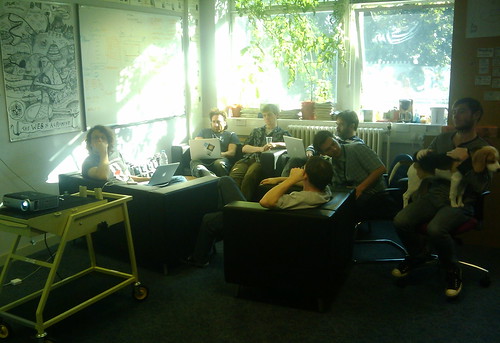Background
As everyone’s been developing in different ways, I wanted to arrange a session to share experiences and come up with best practices - to help us become (a) more consistent and (b) more productive going forward.
We agreed on objectives (20min), explained our current practices (1hr), had a general discussion and debate on deployment and development (1hr), and we then performed an interesting activity @cdent had suggested earlier on, which was to do a group coding session in front of a projector. You could think of it as an enhanced meeting more than “pair programming on steroids”. Part of it was for Chris to explain the tiddlyweb tools that we should be using more, and part of it was to walk through a project lifecycle and critique the stages. This was 2 hours, we concluded the event, and Chris, Fred (@FND), and I remained to refine some of the points into the following summary.
Best Practices and Required Tooling
Best Practices we agreed on:
-
Deployment - Release verticals as SetupTools modules [tarball is for people who want to play with the source egg is for people who just want to install it If you distribute the tarball, you’re effectively distributing the egg; you can build it from the tarball]
-
Deployment - Release mature plugins as SetupTools modules This way, verticals can refer to them as depencies for auto-update (“assemble and aggregate” as @FND put it); in the event of verticals using “immature” plugins (just “.py” files form the web), they can include it in their own package
-
Dev - develop in the dev store, which will be re-created/upgraded We’ll be discussing features for the new/upgraded dev store on irc tomorrow. It will need to offer a way to include files anywhere on the hard drive, and also in remote locations (http; ideally svn, git, etc)
- Dev/Deploy - use bash scripts
- “tiddlyspawn” (name TBA) creates a new project (probably using twinstance, the 2009 AD reincarnation to “twanager instance”, among other things);, inheriting config from tiddlywebwiki.config, make src dir, “parse” setup.py to find dependencies and run “easy_install” on them, perhaps make static dir
-
“build.sh” - inside the project to run updates, pull in remote plugins, build setuptools tarballs for release
- Project dir structure (indicative)
/setup.py # python setuptools recipe - stub's created by build.sh /build.sh # the all-singing build.sh /component.yml # /instance /src /static /dist



